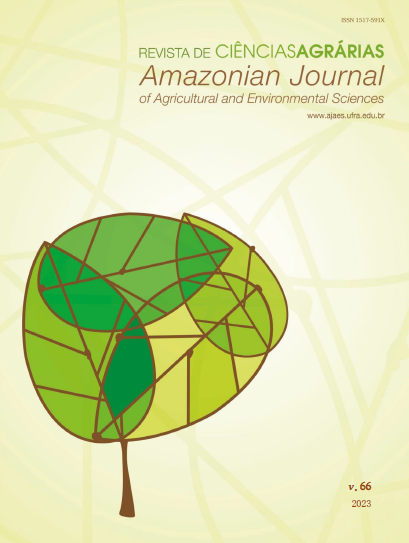Propriedades físicas e de flexão estática do bambu em diferentes idades e posições no sentido longitudinal
Abstract
The consumption of products that have sustainable characteristics has been gaining ground in the market, so it is extremely important to study and understand their characteristics, so that their correct applicability is possible. The present work aimed to evaluate the physical and static bending properties of bamboo. For the execution of the experiment, three individuals of one, two and three years of age were selected, being sectioned in the portions of the base, middle and top. From these, specimens were removed for the aforementioned evaluations, depending on age, different positions in the base-top direction and in two humidity conditions, namely, air-dried at 15% humidity and saturated. According to the results obtained, the moisture content showed a decreasing trend with increasing age and from the bottom to the top. On the other hand, the basic density and the saturated apparent density, at the ages of two and three years, had a tendency to increase in the longitudinal direction. The swelling and contraction in the radial direction, in general, were superior to the tangential one. In the static bending test, the air-dried moisture condition presented the highest averages for MOE (Modulus of Elasticity), MOR (Modulus of Rupture) and TLP (Tension at Poportional Limit) in relation to saturated conditions, in all positions and ages . With this, it is concluded that, from the properties studied, bamboo has a high resistance, especially when used in air dry conditions and mature age.
Downloads
References
AMERICAN SOCIETY FOR TESTING AND MATERIALS(ASTM). Standard Test Methods for Small Clear Specimens of Timber. D-143-96. Vol. 04.10 on Wood. Annual Book of ASTM Standards, ASTM.
BARBOSA, F. G.; SILVA, M. A. A. M.; DE OLIVEIRA, M. B. O uso do bambu como elemento estrutural em moradias. Revista Interdisciplinar Pensamento Científico, v. 6, n. 1, 2020. DOI:http://dx.doi.org/10.20951/2446-6778/v6n1a14.
BERNDSEN, R.S.; KLITZKE, R.J.; BATISTA, D.C.; NASCIMENTO, E.M.; OSTAPIV, F. Resistência à flexão estática e à compressão paralela do Bambu-mossô (Phyllostachys pubescens). Floresta, v. 43, n. 3, p. 485-494, 2013. DOI:10.5380/rf.v43i3.29319.
BRITO, F. M. S. Produção e avaliação da qualidade de painéis aglomerados constituídos por partículas de bagaço de cana-de-açúcar e bambu. Doctoral dissertation, Universidade de São Paulo, 2018.
BRITO, F. M. S.; PAES, J. B.; OLIVEIRA, J. T. S.; ARANTES, M. D. C.; NETO, H. F. Caracterização Anatômica e Física do Bambu Gigante (Dendrocalamus giganteus Munro). Floresta e Ambiente, v. 22, n. 4, p. 559-566, 2015. DOI: https://doi.org/10.1590/2179-8087.033913.
SILVA, W. K. D. DA.; RUBENS, T. D. M.; CABRAL, A. E. B. Caracterização das propriedades físicas da espécie de bambu Bambusa Vulgaris cultivada em Redenção, Ceará-Brasil. XVII Congresso Internacional sobre Patologia e Reabilitação das Construções, 2021. DOI: https://doi.org/10.4322/CINPAR.2021.068.
INSTITUTO DE PESQUISAS TECNOLÓGICAS – IPT. Madeira: o que é e como pode ser processada e utilizada. São Paulo, p. 189, 1985.
JUNIOR, L. S.; MELO, R. R.; DE CASTRO, V. G.; DE SOUZA, M. J. C.; BATISTA, F. G. Qualidade da madeira juvenil de um híbrido clonal (Eucalyptus grandis x Eucalyptus urophylla–H13). Advances in Forestry Science, v. 6, n. 1, p. 523-527, 2019. DOI: 10.34062/afs.v6i1.6488.
LIBRELOTTO, L. I.; OSTAPIV, F. Bambu: Caminhos para o desenvolvimento sustentável no Brasil. Florianópolis - Grupo de Pesquisa Virtuhab/UFSC, 2019.
LUIS, Z. G. L.; NOGUEIRA, J. S.; RIBEIRO, D. G.; SCHERWINSKI-PEREIRA, J. E. Caracterização anatômica dos órgãos vegetativos de bambu (Poaceae, Bambusoideae). Embrapa Recursos Genéticos e Biotecnologia, 2017. Disponível em: https://www.embrapa.br/busca-de-publicacoes/-/publicacao/1084615/caracterizacao-anatomica-dos-orgaos-vegetativos-de-bambu-poaceae-bambusoideae>. Acesso em: 20 junho 2022.
MORAIS, W. W. C. Propriedades físico-mecânicas de chapas aglomeradas produzidas com bambu, pinus e eucalipto. Dissertação Mestrado, Santa Maria, 2011.
NUNES, G. DA M.; SOBRINHO JUNIOR, A. DA S.; PASTOR, J. DOS S. O uso do bambu como material estrutural na construção civil. Revista Principia. Instituto Federal Paraíba, 2021. DOI: http://dx.doi.org/10.18265/1517-0306a2021id4366.
ROSA, R. A.; PAES, J.B.; SEGUNDINHO, P.G.A.; VIDAURRE, G.B.; OLIVEIRA, A.K.F. Influências da espécie, tratamento preservativo e adesivos nas propriedades físicas do bambu laminado colado. Ciência Floresta, v. 26, n. 3, p. 913-924, 2016. DOI: https://doi.org/10.5902/1980509824220.
RUSCH, F.; HILLIG, É.; CEOLIN, G.B. Anatomia de hastes adultas de bambu: uma revisão. Pesquisa Florestal Brasileira, v. 38, 2018. DOI: https://doi.org/ 10.4336/2018.pfb.38e201701530.
SALA, C.M.; ROBLES, E.; GUMOWSKA, A.; KOWALUK, G. Influence of moisture content on the mechanical properties of selected wood-based composites. BioResources, v. 15, n. 3, p. 5503–5513, 2020. DOI: http://doi.org/10.15376/biores.15.3.5503-5513.
SONG, W.; ZHU, M.; ZHANG, S. Comparison of the properties of fiberboard composites with bamboo green, wood, or their combination as the fibrous raw material. BioResource, v. 13, n. 2, p. 3315-3334, 2018. DOI: 10.15376/biores.13.2.3315-3334.
SOUSA, P. M. L. G.; COSTA, J. A.; SILVA, L. C.; CASTRO, C. H. C.; DE SOUSA MACHADO, V.; DUARTE, F. R. L.; DIAS, J. M. S. Metodologia de baixo custo para determinação do modulo de elasticidade a flexão estática de vigas de angelim pedra (Hymenolobium petraeum). Research, Society and Development, v.11, n. 10, 2022. DOI: http://dx.doi.org/10.33448/rsd-v11i10.32633.
Copyright (c) 2024 Carol Stochero, Luana Candaten, Tauana de Souza Mangini, Rômulo Trevisan, Elder Eloy

This work is licensed under a Creative Commons Attribution-NonCommercial 4.0 International License.
Authors retain copyright and grant the Journal the right to the first publication. Authors are encouraged to and may self-archive a created version of their article in their institutional repository, or as a book chapter, as long as acknowledgement is given to the original source of publication. As the Journal provides open access to its publications, articles may not be used for commercial purposes. The contents published are the sole and exclusive responsibility of their authors; however, the publishers can make textual adjustments, adaptation to publishing standards and adjustments of spelling and grammar, to maintain the standard patterns of the language and the journal. Failure to comply with this commitment will submit the offenders to sanctions and penalties under the Brazilian legislation (Law of Copyright Protection; nº 9,610; 19 February 1998).


.jpg)









